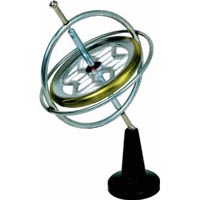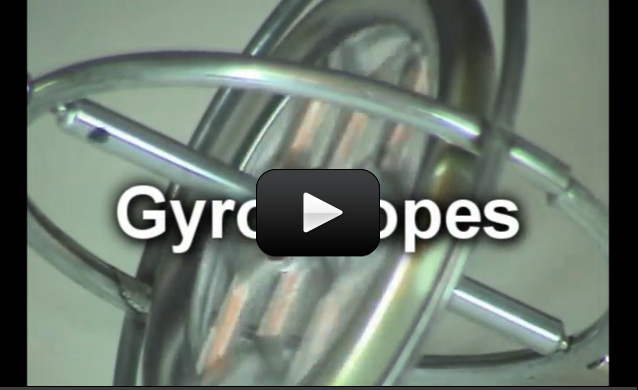 Gyroscopes defy human intuition, common sense, and even appear to defy gravity. You’ll find them in aircraft navigation instruments, games of Ultimate Frisbee, fast bicycles, street motorcycles, toy yo-yos, and the Hubble Space Telescope. And of course, the toy gyroscope (as shown here). Gyroscopes are used at the university level to demonstrate the principles of angular momentum, which is what we’re going to learn about here.
Gyroscopes defy human intuition, common sense, and even appear to defy gravity. You’ll find them in aircraft navigation instruments, games of Ultimate Frisbee, fast bicycles, street motorcycles, toy yo-yos, and the Hubble Space Telescope. And of course, the toy gyroscope (as shown here). Gyroscopes are used at the university level to demonstrate the principles of angular momentum, which is what we’re going to learn about here.
If you happen to have one of these toy gyroscopes, pull it out and play with it (although it’s not essential to this experiment). Notice that you can do all sorts of things with it when you spin it up, such as balance it on one finger (or even on a tight string). Wrap one end with string and hold the string vertically and you’ll find the gyro slowly rotates about the vertical string instead of flopping downward (as most objects do in Earth’s gravitational field). But why? Here’s the answer in plain English:
[am4show have=’p8;p9;p11;p38;p12;p39;p92;’ guest_error=’Guest error message’ user_error=’User error message’ ]
Imagine a spinning bicycle wheel hanging from a rope. Take a freeze-frame image of the wheel in your mind and make the top part of the wheel is at 12 o’clock, the left side at 9 o’clock, the bottom is 6 o’clock, and the center axle pointing toward you. And the wheel was rotating clockwise. Got it?
The 6 o’clock position wants to move to the left. When the 6 o’clock position gets to the 9 o’clock, it still wants to move left.
The original 9 o’clock position wants to move up. When the 9 o’clock position gets to 12 o’clock, it still wants to move up.
The 12 o’clock position wants to move to the right. When the 12 o’clock position moves to the 3 o’clock, it still wants to move right. See the pattern?
Okay, here’s what you want to see now: as the top and bottom (12 and 6 o’clock) positions of the wheel rotate, the forces cancel each other out. Same with the 3 and 9 o’clock positions. And because the wheel is symmetrical, this occurs for every spot on the wheel. When this happens, the bicycle wheel turns (precesses), instead of falling. This is also why a spinning gyroscope will appear to float at the end of the string instead of dangling.
One more piece to the puzzle: the wheel itself is accelerating. Any object that swings in a circle is accelerating, because in order to move in a circle, you need to be constantly changing your direction (or else you’d be off in a straight line tangent to your circular path). When you swing a bag of oranges around your head, or a yo-yo on a string, or even taking a turn in a car, acceleration is happening. We’ll talk more about that when we do our g-force experiments. For right now, let’s get our hands on a super-cool experiment that you usually only see at science museums or inside physics classrooms.
You’ll need to find:
- a bicycle wheel (it needs to be detached from a bicycle – note that the front wheel is pretty easy to detach)
- a piece of rope (about 2-3′)
- and an office chair
1. Carefully hold the bicycle wheel by the axle and give it a spin. Try to get it to spin as fast as you can but be VERY careful to hold onto it tightly and don’t get your fingers in the spokes. It works well if someone else can spin it for you.
2. While it’s spinning try to move it around. You’ll find that the wheel does not want to be moved around and tries to do its own thing when you move it.
3. Take a string and loop it around one side of the axle of the wheel. Spin the wheel fast and let go of the wheel while holding onto the string. The wheel will stay spinning and defy gravity by staying straight up and down. Really! Try it, it’s very cool!
Download Student Worksheet & Exercises
This experiment demonstrates the power of Newton’s Second Law: Force equals mass times acceleration. The mass is the mass of the wheel, in particular, the mass of the tire. The acceleration is the spinning wheel. Remember, acceleration is not just change in speed but also change in direction. Every point on the spinning wheel is constantly changing direction so the wheel is accelerating.
Since acceleration times mass has to equal force, (math says so) the spinning wheel has a force. This force is strong enough to defy gravity and is what you feel when you hold the axles of the wheel and try to move it. This same force is what keeps a top spinning, why footballs are thrown with a spiral, why satellites spin and so on. It’s pretty incredible to think that a force can be created by nothing more than accelerating mass.
Best Physics Joke
A friend once told me of a funny April Fool’s joke played at his office. He worked at a company that fixed aircraft instruments, where they received all sorts of old airplane parts. One day, his office anonymously received an old instrument from a WWII bomber, and the gyro in this thing was HUGE. Then he had an idea – he removed the gyro from the outer instrument casing, fixed it, spun it up (and it would continue spin for hours), and packed it up in his boss’s briefcase. When his boss went to lunch and picked up his briefcase, can you imagine what happened? (Tell me in the comment field below!)
Exercises
- What did it feel like when you tried to turn the wheel after it was spun?
- What direction (orientation) does the wheel want to be in?
- When you were on the spinning chair/platform, which way did you turn?
- If you turned the wheel left, you should have spun the same way, where is the force coming from the pushed you in that direction?
- What happened to the wheel while you held on to the string? Did it stay upright, or dangle?
- Why do you think it stayed upright?
For Advanced Students:
[/am4show][am4show have=’p9;p39;’ guest_error=’Guest error message’ user_error=’User error message’ ]
When you grab hold of the axle of a spinning bicycle wheel, you feel a ‘push’ in an odd direction. This ‘push’ is called precession and is a wobble from the spin axis because you tried to move it in a direction it doesn’t want to go.
Precession happens when you grab a spinning object at its rotating axis (like the ends of the gyroscope or the axle of a bicycle wheel) and try to move it about. You’ll find a fierce resistance crop up. That’s precession. The question is why? Why does the gyro act like this?
Normally, this area of scientific study is enough to make most 3rd year engineering students cry. The engineering required to model this system are complex, let alone finding the solution to the mathematical differential equations that make up the model itself. So we’re not going to get into the nit-picky stuff, but instead talk about how it actually works using plain English. Here’s what’s going on:
Most gyroscopes are designed to have most of the rotating mass far away from the center axis (think of a thin disk with a heavy rim, like a bike wheel) so it can resist motion in certain directions. A spinning bike wheel stores large amounts of energy. Remember Newton’s first law of motion? (An object in motion tends to stay in motion unless something else interferes.) Any time you try to torque the bike axle, the wheel will try to ‘compensate’ for this and push in a different direction. (Parts of a car engine will also do this – think of the fast-spinning shaft or fan when you try to take a sharp turn.)
Who first thought up this stuff?
German scientist Johann Bohnenberger built the first gyroscope as a giant spinning ball near the start of the 1800s. About two decades later, Walter R. Johnson (an American) shifted the spinning solid sphere into a spinning disc, which was later upgraded to describing the Earth’s rotation by a French mathematician Pierre-Simon Laplace. Léon Foucault attempted to use the gyroscope in experiments that could detect the earth’s rotation (while still being on the planet itself), but his work lacked a frictionless mount (which was later developed), and now the famous Foucault Pendulum is in many science museums across the country. (It’s the one with the 3-story tall, 300-pound brass plumb-bob that knocks over dominoes every 6-14 minutes.)
The first industrial application for the gyroscope was for the military (marine applications, then quickly followed for aircraft) in the early 1900s, followed shortly after by the toy industry. Today gyroscopes are used mostly in navigational systems and inertial guidance systems for ballistic missiles.
You can think of the Earth as a gyro as well. Of precession is the ‘wobble’ a spinning gyro makes when a force is applied (the force in this case is the pull mostly from the sun), then the Earth ‘wobbles’ through one precession cycle about every 26,000 years. What does this mean? It means that the axial poles of the earth are scribing small, slow circles over time (the ‘wobble’). It also means that star positions will slowly change on our gridmarked area of the sky, so every so often we’ll need to update our coordinate systems so we can accurately locate the positions of the stars. (But it’s only a shift of about 1 degree very 70+ years.)
The interesting thing is that the Earth’s precession was actually discovered ages ago by the ancient Greek astronomer Hipparchus (150 B.C.), but it couldn’t be mathematically described until we had Newtonian physics to guide the way (and even then we had a few issues). For example, we had to figure out that the Earth is really not a sphere but more of an ‘squashed sphere’ (imagine squashing a ball of clay slightly between your fingers so that the middle bulges out). And both the Sun and the Moon pull on the bulge (lunisolar precession), which adds more to the ‘wobble’ of the Earth. And did I mention the Sun is not a perfect sphere, either? (It’s actually kind of flat… so that had to be accounted for as well.)
All of this can be mathematically modeled in the world of engineering through a conservation law called Angular Momentum. For those of you who really want to learn more about angular momentum (which is purely your choice, but it is out of the scope of this program because it’s a college-level topic), click here to download a chapter from an advanced textbook.
Advanced students: Download your Gyro Wheel Lab here.
[/am4show]


No, we don’t have a recommendation for any specific gyroscopes. There are lots of choices on Amazon or other online sellers.
Do you have a recommendation for a particular gyroscope?